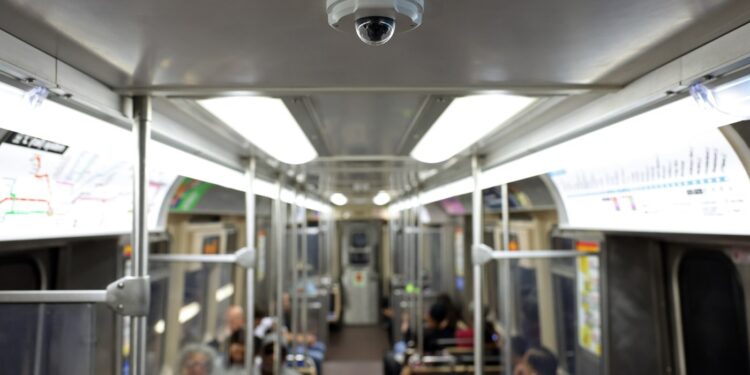
The CTA has begun testing technology that uses artificial intelligence to identify guns in its “L” stations.
The technology, from company ZeroEyes, automatically detects guns that have been brandished. Images are sent to a ZeroEyes operations center where they are reviewed by staffers who determine what the object is, then alert relevant authorities like police, CTA officials and Chicago’s Office of Emergency Management and Communications.
The goal, CTA officials said, is to alert police quickly to any situation arising at the transit agency’s stations. Often the alert can be made in under a minute, they said.
The test program comes as the CTA has grappled with concerns about personal safety, both real and perceived, in recent years, and as the use of different types of technology to address public safety concerns has grown. ZeroEyes technology has at times been used on other public transit systems, and the company touts the use of its program in schools, businesses and other places.
But a separate gunshot detection technology used in Chicago, ShotSpotter, became a political flashpoint earlier this year. Supporters have said the technology — which uses audio sensors to determine the location of potential outdoor gunfire, while ZeroEyes relies on images — helps police arrive quicker at crime scenes and helps critical aid reach gunshot victims more quickly. Opponents, including Mayor Brandon Johnson, labeled it a costly impetus for overpolicing, and the mayor has nodded to studies questioning its effectiveness as a tool to curb crime and catch criminals.
ACLU Illinois spokesman Ed Yohnka said technology like ZeroEyes demands transparency from the CTA, and could lay the groundwork for further intrusive technologies to be used. CTA cameras were marketed as a way to make the system safer, but now another technology needs to be added, he said.
“There are solutions to security issues. I’m not sure that an opaque system being marketed by a company to make money, and not done with sort of citizen input as to how it should work and where people want it to work, I’m not sure any of that is the answer,” he said.
On the CTA, information about the prevalence of specifically gun-related crimes, such as the type that could be detected by ZeroEyes, was not immediately available. The CTA referred questions about crime statistics to Chicago police, and the Police Department said Wednesday it could not immediately provide gun-specific statistics.
The department did say 626 instances of violent crime had been reported on the CTA this year through Aug. 27, up from 547 through the same time period last year.
“One gun on the system is too many, which is why we’re interested in exploring ways to increase our safety on top of the measures that are already in place,” CTA spokeswoman Maddie Kilgannon said.
The technology will join the CTA’s use of unarmed security, K-9 teams and Chicago police to patrol the system. The agency has boosted its security spending in recent years as it has added guards and dog teams, budgeting nearly $65.2 million to purchase security services in 2024. Security service spending was running overbudget through June.
The $200,000 ZeroEyes test run, which has been in place for about a month, will run through summer 2025 to start, CTA Vice President of Security Kevin Ryan said. The program uses the CTA’s existing cameras to detect guns once they have been exposed, and is now installed on more than 250 of the agency’s roughly 30,000 cameras, he said.
ZeroEyes is now being used in CTA train stations across the system, though Ryan declined to specify which stations or train lines have the technology, citing security concerns. He anticipates the program will expand if the test run goes well, which will be determined based on whether the technology works as expected, if law enforcement can respond to any gun reports quickly enough to intervene, or if it works as a deterrent to would-be gun carriers.
So far, the program has detected guns carried openly by law enforcement officers and toy guns, including large electronic water guns, he said. ZeroEyes alerted Chicago and CTA officials to the toy guns, noting they were not believed to be lethal weapons, and then it was up to local officials to determine how to respond, Ryan said.
“One of the reasons I really like ZeroEyes is it has a human component to it,” he said. “It’s not relying on AI or computers to completely do the work.”
Ryan, who once worked for the Chicago Police Department, said officers responding to a call of a person with a gun almost always want more information about what they’re heading to. A picture of the person helps them know what to expect, and helps managers know how best to direct their resources, he said.
“Stuff like that, weapons, it doesn’t happen everyday,” Ryan said. “But when it happens, it has big repercussions to public transit for obvious reasons, so I want a way to mitigate that to the quickest extent possible.”
The technology has been used by other transit agencies, including Philadelphia’s Southeastern Pennsylvania Transportation Authority, which operates a metro, along with buses and regional rail.
But the agency ended a yearlong pilot program with ZeroEyes. The technology wasn’t compatible with SEPTA’s analog cameras, and the agency decided to reallocate funding toward other needs, according to reporting from the Philadelphia Inquirer and the local ABC TV station.
Kilgannon said CTA did not anticipate the same issues. The Chicago agency uses a different camera system that so far has been high-enough quality to be effective, she said.
Originally Published:







